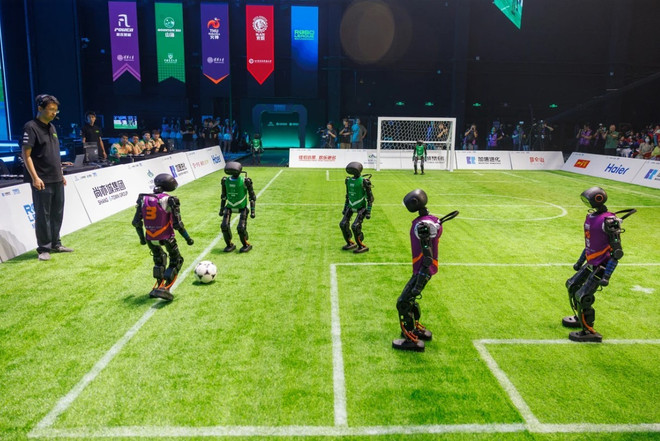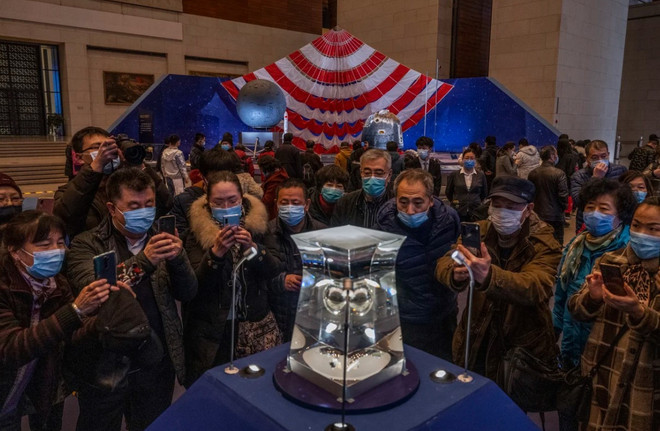A nuclear physicist from the prestigious Princeton University, a mechanical engineer who helped NASA explore the possibility of manufacturing in space, a neuroscientist from the US National Institutes of Health and a host of mathematicians and artificial intelligence experts.
These are just some of the many research talents who have decided to leave the US to work in China.
CNN reported that at least 85 young and veteran scientists who had worked in the US had joined Chinese research institutes to work full-time since the beginning of last year. Of these, more than half had decided to move to China from 2025.
Experts say this trend will continue as the White House under President Donald Trump pushes to cut research budgets and tighten oversight of foreign talent, while Beijing increases investment in domestic innovation.
Most are part of the so-called “reverse brain drain” phenomenon, which has raised questions about America’s ability to attract and retain top scientists, a talent that helped keep the United States at the forefront of science and technology throughout the post-World War II period.
The “reverse brain drain” could have a direct impact on the competition between Washington and Beijing to dominate industries that will shape the future such as artificial intelligence, quantum computing, semiconductors, biotechnology and smart military equipment.
For years, China has sought to attract international talent. Its targets include the thousands of Chinese researchers who left their homeland to pursue graduate studies in the United States and other countries, and have become pioneers and leaders in scientific and technological research in the United States.
The mission of attracting talent is increasingly emphasized as the US maintains strict technology controls on China, and President Xi Jinping sees innovation as the only way to ensure economic security.
Now, as the Trump administration pushes for deep cuts to federal research budgets, increased oversight, skyrocketed the cost of H1-B visas for highly skilled foreign workers, and leveraged federal funding with universities, China’s mission appears to be gaining momentum.
Chinese universities see the changes in the US as a “gift from the Trump administration” that will help them recruit more and better talent, said Yu Xie, a sociologist at Princeton University, who spoke to CNN while visiting Chinese universities earlier this year. “You will see an explosion of new research programs, new training programs. Everything is being strengthened and improved across the board in China,” Xie said.
Congress is expected to reject some of the Trump administration’s proposed deep cuts to research funding for the coming fiscal year. But the cuts and restructuring of science in recent months, along with increased scrutiny of international students and researchers applying for visas, have hit labs and created lingering uncertainty.
Concerns are particularly high among scientists with ties to China, which has long sent more science and engineering doctoral students to the United States than any other country.

Earlier this year, the Trump administration used visas for Chinese students as a bargaining chip in trade negotiations. In July, US lawmakers called for the revival of the “China Initiative,” a controversial national security program launched during Trump’s first term and later canceled over concerns it would increase suspicion and prejudice against academics of Chinese descent.
In recent years, China has welcomed more and more scholars from the US and around the world as its scientific capacity and ambitions have grown. Many of the recent moves were planned before Trump returned to the White House. But current developments in the US may have created a greater advantage for Chinese academic institutions.
A recent editorial in China’s People’s Daily clearly shows how Beijing sees this opportunity, calling China a “safe harbor” and “place to shine” for Chinese and overseas Chinese scholars who are suffering from “reckless interference” from “some Western countries.”
“Do your best”
CNN said that in Chinese universities, most responded to the new opportunities in a discreet way, quietly reaching out to invite researchers from the US to return home.
Lu Wuyuan, a protein chemist who was a professor at the University of Maryland before moving to Fudan University in Shanghai in 2020, told CNN there has been a “clear increase in applications from overseas.” He said the trend of foreign-trained scientists returning to China has become a “strong, perhaps irreversible, flow.”
Of course, there are still some recruitment activities that take place openly online. For example, earlier this year, Wuhan University posted on social media inviting “talents from all over the world to apply” for professor positions. The accompanying salary table showed that those focusing on robotics, artificial intelligence or cybersecurity could receive the highest level of support from the university’s research fund.
Support packages, including preferential access to funding, bonuses, housing subsidies, and family care support, are promoted annually by Chinese universities and are often linked to state funds for “outstanding young talent” from abroad.
Not all programs are academically focused. For example, the Qiming program, which aims to bring top researchers into China’s commercial technology sector, typically requires applicants to have a PhD and work experience abroad. A talent scout in Jiangsu told CNN that the focus of recruitment is on people with advanced expertise in the semiconductor field, to counter US restrictions on technology exports. He said that next year, the focus will likely expand to “artificial intelligence and quantum science, especially quantum communications and precision measurement.”
The Chinese government is also expanding its talent recruitment channels. The Qiming program launched a special recruitment drive this summer, exclusively for talent from the United States and Europe, in a move that has been called “unprecedented.”
Last month, Chinese officials announced that they would introduce a new visa for young talent in science and technology, called the K visa, effective October 1. In July, the National Natural Science Foundation opened an additional round of recruitment for its “outstanding young talent” grant program from abroad, in addition to the annual round held at the beginning of the year.
The US government has for years viewed China's talent programs as a threat, with the FBI calling them part of an "effort to steal foreign technology" for the Chinese government and military.
“A nation prospers when science and technology flourish”
China's long-term efforts to attract and retain talent are also driven by another factor: the country's economic and scientific rise.
More than anyone else, Lu has witnessed the change. He recalls that when he decided to pursue graduate studies in the US in 1989, China was still poor, lacking resources and backward in science and technology.
But much has changed since then. China’s rapid economic growth has coincided with a sharp increase in spending on research and development (R&D). In 2023, China will spend more than $780 billion on R&D, nearly equal to the $823 billion spent by the United States, according to the OECD.
“A country prospers when science and technology flourish,” President Xi Jinping told scholars and senior officials in Beijing last summer, pledging that China would become a “strong” and self-reliant nation in science and technology by 2035.

These efforts have paid off. Last year, China’s ambitious space program returned the first samples from the far side of the Moon. China is leading the way in areas like renewable energy, quantum communications, and even hypersonic weapons. Earlier this year, little-known startup DeepSeek shocked Silicon Valley by launching a chatbot that can compete with OpenAI’s AI model at a much lower cost.
According to the Nature Index, Chinese scientists today publish more research in high-quality natural science and medical journals than their American counterparts. Meanwhile, a series of Chinese universities have entered the top 50 best schools in the world.
However, experts say China still has a long way to go to catch up with the US's scientific leadership, and R&D efforts could be affected by a slowing economy.
“If American universities maintain their funding levels as usual… it will take a long time for China to catch up. But if American universities make mistakes and lose talent, not necessarily to China but to Europe or other places, it will be a disaster for them,” said Fields Medal-winning mathematician Yau Shing-tung, who worked at Harvard University and is returning to Tsinghua University in 2022.
"Short-sighted policy"
Scientists who moved back to China cited a range of reasons for their decision, including wanting to be closer to their aging parents, finding a new chapter in their careers, and contributing to the education of the younger generation. Many in the research community stressed that they do not see science as a zero-sum game, but rather as a job that benefits across borders and relies on international cooperation.
But as Washington and Beijing increasingly see each other as rivals, even a “non-political” decision like choosing a workplace can be seen as political.
In an interview with Phoenix TV, renowned mathematician Zhang Yitang, who built his career in the US since 1985, said that his decision to join Sun Yat-sen University this year partly stemmed from the worsening US-China relationship.
The clearest example of the shift from cooperation to competition is the 2018 China Initiative, which investigated allegations of intellectual property theft in universities, including whether researchers properly disclosed their ties to Chinese institutions.
Despite some convictions, many were later dismissed. The program was eventually abolished in 2022.
On July 22, a letter signed by more than 1,000 American faculty and researchers warned against reviving the program, saying that the China Initiative 2018 ended up recruiting more talent than any other program the country has ever launched.
A 2023 study by Princeton professor Yu Xie and colleagues found that after the China Initiative was implemented, the number of Chinese scientists leaving the US increased by 75%. Of these, about two-thirds chose to return to China.
Among those leaving is Lu, a protein chemist who spent two decades at the University of Maryland studying cancer and infectious diseases. He told CNN that years ago, his research collaboration with China was seen as a prestige boost for the university and for him, until it became the focus of an investigation by the US National Institutes of Health. Lu said his work in China did not conflict with his work, for which he received federal funding.
Now, Lu worries about a deeper breakdown in US-China scientific cooperation, which has been so beneficial to both sides. “There is no doubt that the short-sighted policies of the current administration have stifled US-China scientific cooperation. Ironically, the US may suffer much more than China, which is rapidly and confidently emerging as a scientific and technological powerhouse,” he said./.
Source: https://www.vietnamplus.vn/ben-trong-cuoc-chay-mau-chat-xam-nguoc-tu-my-ve-trung-quoc-post1066094.vnp


![[Photo] General Secretary To Lam, Secretary of the Central Military Commission attends the 12th Party Congress of the Army](https://vphoto.vietnam.vn/thumb/1200x675/vietnam/resource/IMAGE/2025/9/30/9b63aaa37ddb472ead84e3870a8ae825)
![[Photo] President Luong Cuong receives President of the Cuban National Assembly Esteban Lazo Hernandez](https://vphoto.vietnam.vn/thumb/1200x675/vietnam/resource/IMAGE/2025/9/30/4d38932911c24f6ea1936252bd5427fa)

![[Photo] Panorama of the cable-stayed bridge, the final bottleneck of the Ben Luc-Long Thanh expressway](https://vphoto.vietnam.vn/thumb/1200x675/vietnam/resource/IMAGE/2025/9/30/391fdf21025541d6b2f092e49a17243f)
![[Photo] Solemn opening of the 12th Military Party Congress for the 2025-2030 term](https://vphoto.vietnam.vn/thumb/1200x675/vietnam/resource/IMAGE/2025/9/30/2cd383b3130d41a1a4b5ace0d5eb989d)
![[Photo] The 1st Congress of Phu Tho Provincial Party Committee, term 2025-2030](https://vphoto.vietnam.vn/thumb/1200x675/vietnam/resource/IMAGE/2025/9/30/1507da06216649bba8a1ce6251816820)































































































Comment (0)